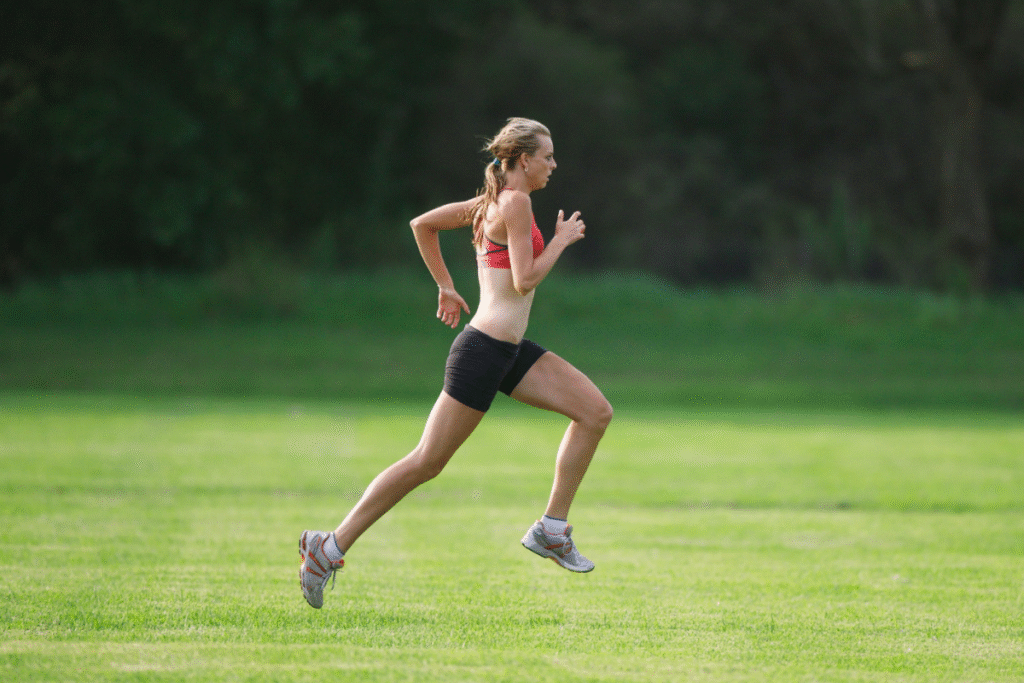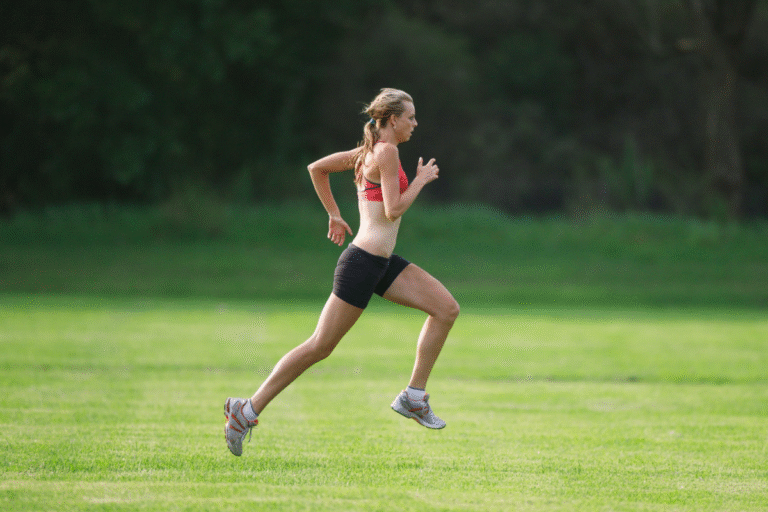
“I don’t have the time or energy to work out every day—and cardio just makes me more tired.”
That’s something I hear all the time from my perimenopausal clients.
And honestly? They’re right.
When your hormones are shifting and your stress is high, the last thing your metabolism needs is more time on the treadmill.
What it does need is smarter training—and that’s where Sprint Interval Training (SIT) comes in.
🏃♀️ What Is Sprint Interval Training (SIT)?
Sprint Interval Training (SIT) is a science-backed method of short, all-out bursts of effort followed by full recovery periods. It’s a form of high-intensity exercise, but it’s different from traditional HIIT in one key way:
SIT focuses on fewer, more intense sprints with longer rest periods—so your body can recover, rebuild, and actually benefit from the stimulus.
A basic SIT workout might look like:
- 4–6 rounds of 20–30 seconds of all-out sprinting or effort
- Followed by 1.5 to 4 minutes of slow walking or full rest
- Total workout time: 10–20 minutes max
This format is ideal for midlife women because it delivers big results with less time and less hormonal fallout.
🔥 Why Sprint Interval Training Works So Well in Midlife
During perimenopause and menopause, your metabolism naturally begins to slow down due to:
- Declining estrogen and progesterone
- Loss of lean muscle mass
- Increased insulin resistance
- Elevated baseline cortisol from chronic stress
SIT helps reverse these trends by:
✅ Building lean muscle in a time-efficient way
✅ Improving insulin sensitivity—making it easier to burn fat and regulate energy
✅ Increasing mitochondrial function, which boosts metabolic rate
✅ Enhancing cardiovascular health without prolonged stress on your body
✅ Spiking growth hormone and other fat-burning hormones naturally
The best part? You don’t need hours in the gym. Just 1–2 SIT sessions per week, combined with strength training and daily walking, can completely change how your body feels and functions.
😵 HIIT vs SIT: What’s the Difference?
You’ve probably heard of HIIT (High-Intensity Interval Training)—and maybe even tried it. While it works for some, HIIT can backfire for midlife women if it’s too frequent or intense.
| HIIT | SIT |
| Moderate to high effort (70–90%) | All-out effort (90–100%) |
| Short rest periods (15–60 sec) | Long rest periods (90 sec – 4 min) |
| Often 20–45 min sessions | Usually 10–20 min sessions |
| Can lead to cortisol spikes if overused | Promotes hormonal balance with proper recovery |
SIT respects your recovery capacity, which is crucial for hormone health.
⏳ What Happens If You Don’t Adjust Your Cardio Strategy?
Many women in midlife double down on cardio when they feel weight gain creeping in—but this often backfires.
Excessive steady-state cardio can lead to:
- Increased cortisol and adrenal fatigue
- Muscle loss, which slows metabolism
- Hormonal imbalances (worsening PMS, hot flashes, or sleep problems)
- Chronic fatigue, joint pain, and inflammation
SIT gives you the burn without the burnout.
🧠 How to Know If SIT Is Right for You
SIT is best for women who:
✔️ Are generally healthy and cleared for moderate/high-intensity activity
✔️ Are short on time but want big results
✔️ Want to break through a weight loss plateau
✔️ Are experiencing midlife metabolic slowdown
🚫 It’s not ideal if you’re currently:
- Severely adrenal-fatigued or recovering from burnout
- Experiencing active injury or pain
- Brand new to movement (you’ll want to build a base first)
Always consult your provider before starting a new exercise program—especially if you have cardiovascular or hormonal concerns.
🏋️♀️ How to Get Started with SIT
Here’s a sample beginner-friendly SIT workout (no treadmill required!):
Warm-Up:
- 5 minutes brisk walk or dynamic stretching
Sprints (Repeat 4–6 times):
- 20–30 seconds: All-out sprint, bike, or hill climb
- 2–4 minutes: Full rest or slow recovery walk
Cool Down:
- 3–5 minutes light walk + deep breathing
Start with 1x per week, and only add a second session if your energy, sleep, and recovery stay solid.
🧬 How SIT Fits Into a Metabolic Reboot Plan
For women over 40, the best results happen when SIT is part of a bigger lifestyle framework:
- Strength training 2–4x/week
- Daily walking and non-exercise activity
- Protein-rich, anti-inflammatory meals
- Restorative sleep and stress management
- Targeted supplements or BHRT (when appropriate)
SIT isn’t a miracle fix—but when combined with the right support, it can be the spark that reignites your metabolism.
💡 How Antigravity Wellness Helps You Implement SIT Safely
At Antigravity Wellness, we tailor every protocol to the individual—including your movement plan.
If you’re a client, we’ll assess your readiness for SIT, guide your programming, and monitor your results as part of our Hormone Harmony Method.
We also offer:
- Customized exercise routines inside our strength and hormone programs
- Nutrition and supplement guidance to support recovery
- Access to expert coaching and BHRT (for WA & OR residents)
- A whole-person approach to midlife health that includes lifestyle, labs, and long-term planning
🎯 Ready to Try SIT With Support?
📞 Book a Brief Initial Consult with Dr. Nicole Smith HERE
🎁 Mention “July Special” during your call to get a FREE starter pack when you book your next service
⚠️ Medical Disclaimer
This blog post is for educational purposes only and does not constitute medical advice. Please consult your healthcare provider before beginning any exercise, supplement, or treatment plan.
📚 References
- Metcalfe RS, et al. “Extremely short-duration high-intensity training improves insulin action in young healthy males.” BMC Endocrine Disorders. 2012. https://bmcendocrdisord.biomedcentral.com/articles/10.1186/1472-6823-9-3
- Whyte LJ, Gill JM, Cathcart AJ. “Effect of 2 weeks of sprint interval training on health-related outcomes in sedentary overweight/obese men.” Metabolism. 2010. https://pubmed.ncbi.nlm.nih.gov/20153487/
- Gibala MJ, Little JP. “Physiological adaptations to low-volume, high-intensity interval training in health and disease.” J Physiol. 2010. https://pmc.ncbi.nlm.nih.gov/articles/PMC3381816/




